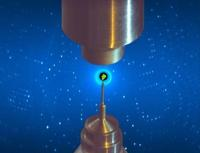Speaker
Description
Upon protein ligand binding, changes of conformational entropy occur in protein and hydration layer. In an experimental study, we investigated the relevance of conformational entropy for the binding of biotin to the protein streptavidin. Using QENS, we investigated changes in conformational entropy between the ligand-free and the ligand-bound state. We compared the internal dynamics of streptavidin before and after biotin binding. Thermal Diffusion Forced Rayleigh Scattering (TDFRS) was used to gain information on the hydration layer.
QENS results show that the conformational entropy of streptavidin reduces upon biotin binding. TDFRS results and extrapolation from QENS data and literature data indicate an increase in hydration layer entropy upon biotin binding. This indicates that the hydration layer plays an important role in stabilising the binding of biotin to streptavidin. The change in conformational entropy per residue upon biotin binding to streptavidin is of the same order of magnitude as that in protein folding processes. This indicates that a significant change of conformational entropy occurs upon biotin binding to streptavidin. This is remarkable, since no significant structural change occurs upon binding. The internal dynamics show that the residues of free streptavidin perform a jump-diffusive motion in the picosecond timeframe, while the more rigid complex does not show jump-diffusive motions. I will discuss how different biotin saturations affect this.

